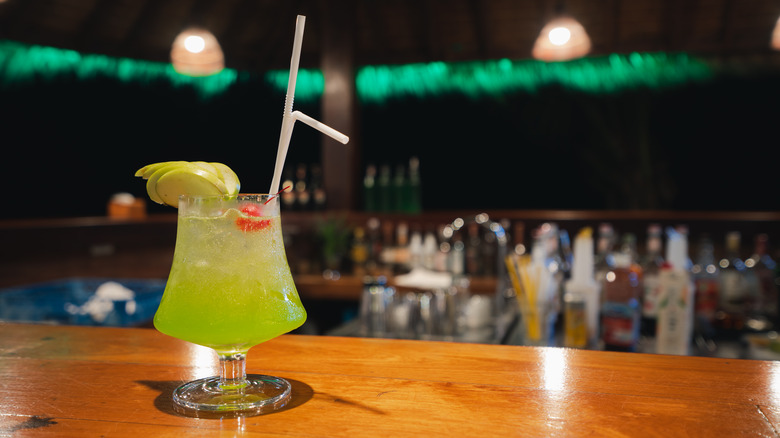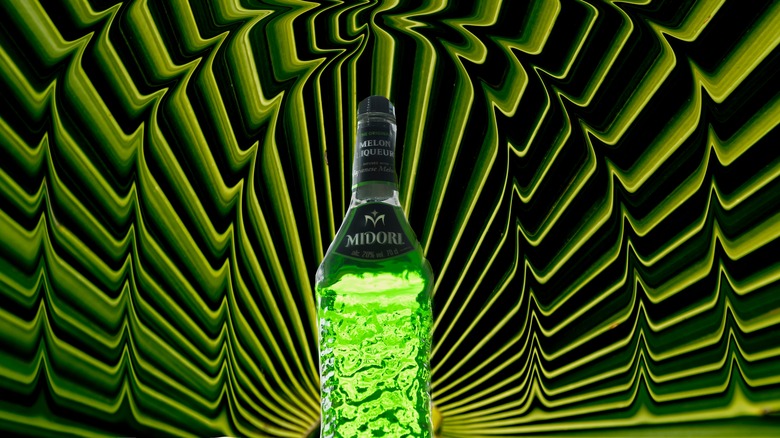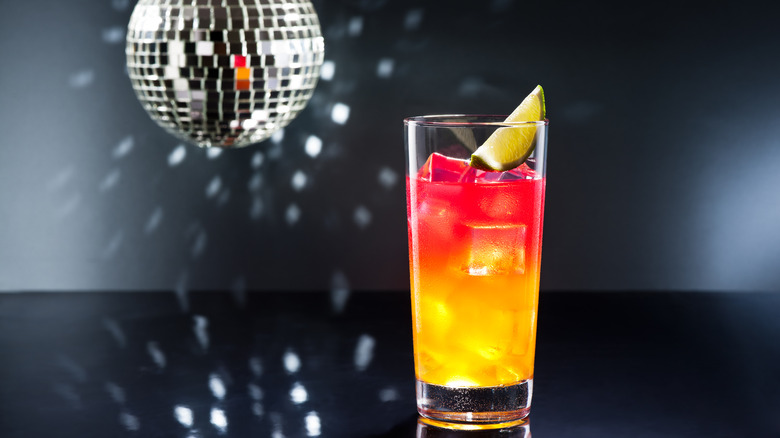Why The Midori Sour Cocktail Owes Its Existence To Studio 54
In the world of cocktails and liqueurs, Midori is unique. When a recipe like a Sauza Midori margarita calls for this bright green liqueur, there isn't much that you can substitute to get the same fresh flavors — and when it comes to the iconic Midori Sour, there's definitely no substitution. Although the origin stories of many famous cocktails are hotly debated, we do know exactly when and where Midori hit U.S. shores.
Midori was introduced in the 1960s. At first, this liqueur hit the market in its native Japan, where it was developed by Shiniiro Torii, who wanted to create a liqueur inspired by the flavors of Japanese melons, muskmelons, and yubari fruit, while still having Western-world vibes. Midori was first sold in 1964, attracted international attention in 1971, and 1978 it became the first fruity liqueur to hit the U.S.
This bright green liqueur debuted at Studio 54 during the launch party for one of the decade's biggest movies. It's no wonder it became wildly popular, making brightly colored cocktails that embodied the fun atmosphere of the '70s-era disco scene. After hitting in a big way, Midori-based cocktails — particularly the Midori Sour — have recently received a 21st-century update, and they're back on the dance floor.
Midori was forever linked to Studio 54 and a movie launch party
Initially, the liqueur was called Hermes Melon Liqueur, but it had already been renamed by the time it hit the U.S. Midori premiered at a movie launch party held at Studio 54. It's almost impossible to describe what a big deal the club was: Those inside were rubbing shoulders with 70s-era superstars like Liza Minelli, Andy Warhol, and Elizabeth Taylor, and the nightly escapades were pretty wild; wanted to get a glimpse of Bianca Jagger riding a white horse led by a man wearing nothing but body paint? Studio 54 was where it was all happening.
The movie premiere in question was a big deal, too. "Saturday Night Fever" hopped on a disco bandwagon that was already going strong and started filming the same year that Studio 54 opened. At the launch party, Midori was a drink of choice for a who's-who list of celebs.
Midori became associated with the nightclub scene of the 1970s, and while it never quite went away, it did get a new lease on life when parent company Suntory overhauled the liqueur in 2012. Now, with more all-natural flavorings and new packaging, it has again become a favorite of bartenders looking to up their game with reimagined versions of classic favorites. And disco? In 2016, the "Saturday Night Fever" dance floor sold for $1.2 million at auction. Disco hasn't gone the way of the dodo, either.
There are a number of classic cocktails that became firmly associated with the disco scene
Midori wasn't the only thing being served up during wild days at disco nightclubs: There's also the Harvey Wallbanger, the minty Grasshopper, the tropical Piña Colada, and Blue Hawaiian, and the undeniably beautiful Tequila Sunrise. The New York bar scene of the 1970s included not only Studio 54 but also other big clubs like CBGB, which might make one wonder why this particular scene spawned so many famous cocktails.
A few things are going on here, starting with the fact that those there stressed that it wasn't just about drinking; it was about dancing, socializing, and finding a community among the corrupt that was '70s-era New York City. In an interview with Punch, longtime resident and Queens native Al Suarez explained that for many, bars and nightclubs were the only place people could find that sense of belonging. "People would move away," he explained, "and when they came back to New York, they knew that everybody would make their way to the local bar on Saturday." That's a powerful thing.
Another big factor was that dinner parties — often in homes featuring drink trolleys and cocktail bars — made it easier for people to serve the same kinds of drinks enjoyed by the rich and famous in places like Studio 54. Many popular drinks had been invented decades before, but the '70s moved these bright and colorful cocktails out of the nightclubs and into the home.


